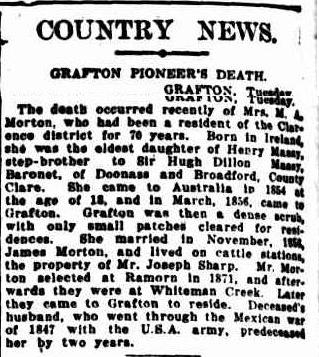This obituary initially caught my eye because of the links to Broadford and Doonass. Mary Ann Massy, later Morton, is reported as the eldest daughter of Henry Massy, step-brother to one of Clare’s famous land-owners, Sir Hugh Dillon Massy.

COUNTRY NEWS. (1926, February 4). The Sydney Morning Herald (NSW : 1842 – 1954), p. 12. Retrieved March 18, 2014, from http://nla.gov.au/nla.news-article16280235
However as I explored further, more information came to light, emphasising the importance of seeking out multiple sources. While there are common threads between most of these obituaries, each adds something new. By the end of the reading we have a more holistic idea of her life. One unusual omission is any reference to children though they are mentioned in the final story, a tale of black-white conflict on the colonial frontier. An interesting connection is her husband’s involvement with the US Army in the Mexican War, another frontier battle.
Mary Ann Massy was 90 when she died. She had been born in Limerick and arrived in 1854 aged 18 according to the reports but the NSW state records reveal she was 19 when she arrived on the Patrician in 1854 (her occupation given as a laundress) with her relative, Mrs Lubling who was in business in Sydney (see her husband’s story here). Mary Ann stated her place of origin as County Clare.
Mary Ann moved to the Clarence in 1856 with Mrs Greaves, the surveyor’s wife, for whom she worked (Brisbane Courier 4 February 1926, page 18). Mary Ann was married to James Morton in November 1856 by Rev AE Selwyn, later Bishop of Newcastle. The couple lived on the cattle stations of Mr Joseph Sharpe before selecting property at Ramorn(ie) in 1871 before moving to Whiteman Creek and later Grafton. The couple were early settlers in the Clarence area, and Mary Ann lived there for 70 years. James Morton was with the US Army during the Mexican War in 1847. He died two years before Mary Ann, in 1924. His obituaries are particularly interesting so I’ll be including them in a Trove Tuesday post today on my main family history blog.

OBITUARY. (1926, February 13). The Queenslander (Brisbane, Qld. : 1866 – 1939), p. 16. Retrieved March 18, 2014, from http://nla.gov.au/nla.news-article22751715

PERSONAL NEWS. (1926, February 10). Morning Bulletin (Rockhampton, Qld. : 1878 – 1954), p. 6. Retrieved March 18, 2014, from http://nla.gov.au/nla.news-article55255434

MRS. MARY MORTON. (1926, February 12). The Land (Sydney, NSW : 1911 – 1954), p. 18. Retrieved March 18, 2014, from http://nla.gov.au/nla.news-article116261642
What’s noticeable is the absence of children mentioned in any of the obituaries, yet the level of detail suggests that information has been obtained from someone close to the family, and they are mentioned in the following list. This list of potential children comes from NSW BDM indexes. Their son, Henry (Frank) McK Morton, listed above appears to be the one who died in 1929 and who also has an interesting obituary. One child has been named for both Mary’s ancestors and also James’s father (William McKeown Morton):
| 7000/1857 | MORTON | MALE | JAMES | MARY A | GRAFTON | |
| 8162/1863 | MORTON | MALE | JAMES | MARY A | GRAFTON | |
| 9261/1865 | MORTON | HENRY MCE | JAMES | MARY A | GRAFTON | |
| 11401/1874 | MORTON | MATILDA ELIZA | JAMES | MARY ANN | GRAFTON | |
| 12387/1876 | MORTON | LILLY MARGARET | JAMES | MARY ANN | GRAFTON | |
| 12285/1871 | MORTON | MASSY MCKEOWN | JAMES | MARY ANN | MACLEAY RIVER |
And a child’s death, as well as the two males listed above. The gravestones can be seen on the Australian Cemeteries Index site.
| 3757/1862 | MORTON | MARY A | JAMES | MARY A | GRAFTON |
As Mary Ann’s husband, James, is buried in the Grafton Cemetery it seems likely that Mary Ann is as well, and either her name is not on the gravestone or it has eroded over time. It appears these are their death entries:
| 4363/1926 | MORTON | MARY A | HENRY | CATHERINE | GRAFTON |
| 2521/1924 | MORTON | JAMES | WILLIAM MCK | MARGARET | GRAFTON |
Mary Ann’s early colonial life was at the interface of the frontier of black-white relationships. I’ve pondered whether to include this story however I think it’s an important part of our colonial history. A similar story was published in Lismore’s Northern Star on 1 February 1926. While the language, and even more the events, are confronting to us in the 21st century it reveals the battle between the races as the British assumed that they had occupied Terra nullius and the Aborigines were fighting for their land, and survival. Probably few of our earliest Australian ancestors were free from these actions or attitudes so perhaps it’s best for our sensitivities that obituaries rarely make mention of them.

THE BLACK RAIDERS. (1926, February 8). The Richmond River Express and Casino Kyogle Advertiser (NSW : 1904 – 1929), p. 5. Retrieved March 18, 2014, from http://nla.gov.au/nla.news-article123061705
